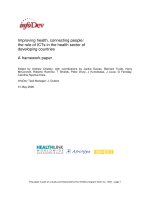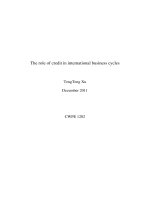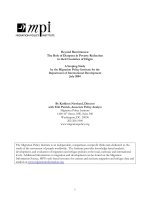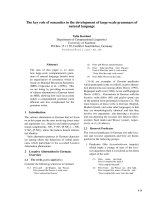role of finance in development 2018
Bạn đang xem bản rút gọn của tài liệu. Xem và tải ngay bản đầy đủ của tài liệu tại đây (636.25 KB, 10 trang )
Development Finance, MPP, VJU
Prof. K. Fujimoto
Class 2 Role of Finance in Development
1. Roles of the Financial System
(1) Definition of “Finance in Development”
Finance in Development can be defined as a “Financial System at Large.” The
financial system does, therefore, encompass financial markets (e.g. money market),
financial institutions (e.g. banks), and financial policies and related policy measures
as a whole.
(2) Three Functions of the Financial System
(i) Settlement Function or Administering the Country’s Payments Mechanism
This function permits that, through a bank’s A/C, buyers and sellers can settle the
transaction of commodities without handling cash, which implies less risk and
less trouble.
(ii) Intermediation Function or Intermediating between Savers and Investors
In the financial system, funds flow from those who have surplus funds to those
who have a shortage of funds, either by direct, market-based financing or by
indirect, bank-based finance.
(iii) Function to Provide Stages Where a Variety of Economic Policies are Exercised
Via the financial system, various economic policies are exercised. Some of these
are the monetary policy vis-à-vis the price stabilization policy, the foreign
exchange policy and the industrial policy vis-à-vis the credit rationing/incentive
interest policy.
These functions prevail not only within developed countries but also developing
countries.
2. Economic Development and the Financial System
(1) Financial Repression and Keynesian Economics (From 1945 through the Middle of
the 1970s)
kiềm chế
(i) Why the repression policy was widely accepted and exercised?
Financial repression consists of various measures, such as interest rate ceilings, high
bank reserve requirements, liquidity ratio requirements, government directives on
the directions of credit and so forth. And policies of financial repression were
exercised between 1945 to the middle of the 1970’s.
There are two fundamental reasons why the repression policy was widely
policy --- policy measure
strategy --- tactics
1
direction --- how to go
to reach the destination --- how to reach....
chú ý khi viết
conclusion thesis
Development Finance, MPP, VJU
Prof. K. Fujimoto
supported and exercised during this period. (a) Keynesian economics which is
characterized as economics of effective demand to which government interventions
are regarded essential and (b) central planning economies of the socialist countries
were experiencing a relatively successful economic growth. Thus, the role of
government was well regarded as an intervening measure to manage economic
growth.
(ii) Components (policy measures) of the repression policy
a. Interest rate ceilings
Interest rate ceilings are set deliberately below the competitive free market
equilibrium rate of interest so that credit can be allocated on non-price criteria. In
this way, the private sector can be encouraged to undertake the centrally planned
investment even though those projects might well be unprofitable at the market
interest rate. For instance, the loan interest rate ceilings have been used in
conjunction with import restrictions to encourage industrialization through
import substitution (an industrial development policy).
Structuralists and neo-structuralists insist that raising interest rates increases
inflation in the short run through a cost-push effect and lowers the rate of
economic growth at the same time by reducing the supply of credit in real terms
available to finance investment. Thus, their models (of, say, interest rate ceilings)
provide an intellectual justification for financial repression.
Governments often impose a ceiling on the interest rate that banks can offer to
depositors. Interest ceilings function in the same way as price controls, and
thereby provide banks with economic rents. These rents benefit the incumbent
banks and provide tax sources for the government, paid for by savers and
borrowers.
b. High bank reserve requirements
High bank reserve requirements are another policy measure of financial
repression. A bank must hold cash in reserve against deposits made be customers,
which is usually kept in the central bank. Governments require banks to meet
high reserve ratios, and use the reserves as a method to generate revenues.
Because reserves do not earn interests, reserve requirements function as an
implicit tax on banks and also restrict banks from allocating a certain portion of
their portfolios to investments and loans. Consequently, the high bank reserve
requirements reduce the money supply in the economy and result in interest rate
hike. Thus, the reserve requirements have fiscal as well as monetary implication.
c. Liquidity ratio requirements
2
Development Finance, MPP, VJU
Prof. K. Fujimoto
A variant of the reserve requirements includes required liquidity ratio which
refers to highly liquid assets held by banks to meet short-term obligations. For
instance, banks are required to allocate a certain fraction of their deposits to
holding government securities that usually yield a return lower than could be
obtained in the market. Another fiscal implication as a source of government
revenue.
d. Government directives on the direction of credit
Financial repression also takes the form of government directives for banks to
allocate credit at subsidized rates to specific firms and industries to implement
industrial policy. Government directives and guidance sometimes include
detailed orders and instructions on managerial issues of financial institutions to
ensure that their behavior and business is in line with industrial policy or other
government policies.
(iii) Fiscal implication of financial repression
In practice and reality, however, the predominant rationale for financial repression
lies in its fiscal implications. Interpreted as a discriminatory tax on the financial
intermediation, financial repression comprises high reserve requirements, liquidity
ratio requirements, interest rate ceilings and government directives on the direction
of credit and exchange controls. This implies that, if institutional constraints prevent
the government from collecting adequate normal tax revenue to finance the level of
government expenditure it regards as optimal, financial repression may be justified
as a second-best strategy.
The combined effect of the above financial repression measures implies that the
government can funnel funds to itself without going through legislative procedures
and more cheaply than it could when it resorts to market financing.
The financial repression policy is meant to make more use of the third function,
namely, “stages where various economic policies are practiced” within the financial
system.
(2) McKinnon-Shaw (Ronald I. McKinnon and Edward S. Shaw) Model and Financial
Liberalization (~From the Middle of 1970s through the Early 1980s~)
The financial repression measures described above, which are often introduced under
fiscal exigencies, reduce the incentive to hold money and other financial assets, and
so reduce the overall availability of loanable funds to investors. Not only may the
credit shortage encourage more low-yielding self-financed investment, but low
3
Development Finance, MPP, VJU
Prof. K. Fujimoto
subsidized interest rates to priority borrowers may also reduce the average return on
credit-financed investment.
The McKinnon-Shaw model formalizes these ideas, showing that financial
repression reduced both the quantity and the quality of investment in the economy as
a whole. The McKinnon and Shaw model, thus, advocates financial liberalization
which allows market forces to determine the rate of interest -the model postulates that
as interest rates rise towards competitive equilibrium, it will have a positive effect on
savings and investment. This leads to the efficient allocation of capital, which
perpetuate the development process or economic growth. Since 1973 the McKinnonShaw financial liberalization paradigm has exerted considerable influence on
macroeconomic policy in developing countries, particularly through the
recommendations of the IMF and the World Bank.
McKinnon also pointed out that financial repression encourages economic
dualism, while Krugman (Paul Robin) shows that financial repression can worsen
income distribution, but need not necessarily cause economic dualism. However,
Galbis showed that financial repression not only worsens income distribution but also
maintains economic dualism.
The financial liberalization policy is meant to make more use of the second
function, namely, “intermediation function” within the financial system.
⇒ McKinnon’s Model
⇒ Shaw’s Model
(See Maxwell J. Fry, Money, Interest, and Banking in Economic Development, 1995
and Emancipating the Banking System and Development Markets for Government
Debt, 19)
(3) The Financial and Banking Crisis ~1982 onwards~
(i) Banking Crises Experienced in the Past
Although the financial liberalization policy was pursued since the mid-1970s, quite
a number of developed and developing countries experienced banking crises.
According to an IMF survey, 133 countries out of 181 member countries experienced
serious banking crises from 1980 through the late 1990s. Such proliferation of largescale banking sector problems has raised widespread concern, as banking crises
disrupt the flow of credit to enterprises and households, reducing investment and
consumption and possibly forcing viable firms into bankruptcy. A banking crisis may
also jeopardize the functioning of the payments system and, by undermining
4
Development Finance, MPP, VJU
Prof. K. Fujimoto
confidence in domestic financial institutions, they may cause a decline in domestic
savings and/or a large-scale capital outflow. Finally, a systemic crisis may force
sound banks to close their doors.
The definition of a banking crisis may be as follows:
Financial Distress: “when a significant fraction of the banking sector is insolvent
but remains open”
Financial Panic: “when bank debt holders suddenly demand that banks convert
their debt claims into cash to the extent that the banks are forced
to suspend the convertibility of their debt into cash”
The four indicators below may define a banking crisis more objectively and
systemically.
-
Non-performing loans occupy at least 10% of total assets.
-
Cost of rescue operations is more than 2% of GDP.
Banking problems result in largescale nationalization of banks.
Emergency measures, such as deposit freeze, prolonged bank holidays,
generalized deposit guarantees are introduced.
(ii) Causes of Banking Crises
The causes of banking crises can be divided into two categories: microeconomic
ones (bank specific or bad banking), and macroeconomic ones (bad operational
environment).
a. Microeconomic/Bad Banking Factors
A banking crisis often has its roots in poor bank operations including one of even
possibly more of the following: poor lending practices, excessive risk taking,
poor governance, lack of internal controls, focus on market share rather than
profitability, and currency and maturity mismatches in the banks themselves or
among their borrowers.
b. Macroeconomic/Bad Operating Environment Factors
A banking crisis can arise from macroeconomic causes that are external to the
banking system as well. Even a well-run banking system operating in a strong
legal and regulatory framework can be overwhelmed by the effects of a poor
macroeconomic environment against inadequate policies. Macroeconomic
difficulties may arise from lending booms, possibly stoked by excessive capital
inflows or changes in tax rules; real estate and/or equity price bubbles that inflate
and burst; slowdown in growth and/or exports, or the loss of export markets;
5
Development Finance, MPP, VJU
Prof. K. Fujimoto
growing excess capital/falling profitability in real sector; lower overall
investment; rising fiscal and/or current account deficits; weakened public debt
sustainability; sharp changes in exchange rates and real interest rates; and so on.
Not all of these developments are under the control of the authorities but
governments must be ready to adapt macro policies that take the conditions of a
systematically distressed banking system into account.
(See Speech Manuscript of Mr. Stefan Ingves, Director of IMF, delivered on
April 8, 2003 in Buenos Aires)
(iii) Sequential Responses to Banking Crises by the Banking Authorities
a. A Ten Step Approach
Steps 1 to 4. The acute crisis phase: measures to stop the panic and stabilize
system.
Step 1. The crisis usually begins because, in one form or another, there is
excessive leverage in the economy. In the early stages there may
also be a degree of denial on the part of the banks and the
government.
Step 2. Bank runs by creditors and depositors start and intensify. The central
bank responds by providing liquidity support to the affected banks.
Step 3. When central bank liquidity is unable to stop the runs, the
government announces a blanket guarantee for depositors and
creditors. Such a measure is intended to reduce uncertainty and to
allow time for the government to begin an orderly restructuring
process.
Step 4. All along, the central bank tries to sterilize its liquidity support to
avoid a loss of monetary control. khử
dividend
bank-run
equity
loan
debt
bank share
capital
Steps 5 to 8. The stabilization phase: measures to restructure the system
Step 5. The authorities design the tools needed for a comprehensive
restructuring, including the required legal, financial, and
institutional framework.
Step 6. Losses in individual institutions are recognized. The authorities shift
the focus from liquidity support to solvency support.
Step 7. The authorities design a financial sector restructuring strategy, based
on a vision for the post-crisis structure of the sector.
Step 8. Viable banks are recapitalized, bad assets are dealt with, and
prudential supervision and regulations are tightened.
6
Development Finance, MPP, VJU
Prof. K. Fujimoto
Steps 9 to 10. The recovery phase: measures to normalize the system.
Step 9. Nationalized banks are re-privatized, corporate debt is restructured,
and bad assets are sold.
Step 10. The blanket guarantee is revoked, which, if properly handled, is a
nonevent because the banking system has been recapitalized and is
healthy again.
(See Carl-Johan Lindgren and Others (1999), Financial Sector Crisis and
Restructuring: Lessons from Asia, IMF Occasional Paper No. 188.)
b. Short-term and Long-term Approach
Short-term Responses:
In order to prevent the financial/banking system from collapsing,
macroeconomic as well as bank-specific responses are required. In case that
a currency crisis is involved, a comprehensive macro stabilization policy
whose formulation and implementation are supported by IMF has to be
implemented. In this case, therefore, the banking crisis has to be taken care
of within the macroeconomic stabilization policy.
Bank-specific responses include interest rate increase(s) to absorb
liquidity and prevent capital flight, liquidity supply and blanket guarantee
(together with deposit insurance organizations, if any) to restructure banking
institutions (suspension, nationalization, closure, and so on).
Long-term Responses:
Bank’s Corporate Governance; banks are required to pursue accountable
and transparent management. One of the measures would be the
introduction of new accounting rules and regulations vis-à-vis đối diện
evaluating land and other assets values, reflecting risks of foreign
exchange fluctuations and so on.
thận trọng Prudential Regulations; prudential regulations cover factors such as
Capital adequacy, Asset quality, Management ability, Earnings and
Liquidity (CAMEL in short). Through strengthening these factors,
banks upgrade their soundness.
Strengthening the Bank Inspection Capacity of the Banking Authorities;
the banking authorities must acquire knowledge and the expertise to
supervise banks on and off site.
Promotion of Sound Competition among Banks and Pursuance of Selfresponsible Management; the banking authorities must introduce
7
Development Finance, MPP, VJU
Prof. K. Fujimoto
effective policy measures to promote competition among banks and
establish objective and clear criteria to suspend, transfer or liquidate
banks upon their performances.
(iv) Costs of Instability in the Banking System
According to empirical research, the costs of banking crises measured in terms of
fiscal expenditure tend to be larger in lower-income countries and those with
higher degrees of banking intermediation. Countries with large fiscal costs of
crisis have in the past often experienced a simultaneous currency crisis, especially
those that had in place a fixed exchange rate regime. Further, the output losses
that incurred during the crisis period are large, 15% to 29% on average of the
annual GDP. Output losses are usually much larger in the event of a twin
banking/currency crisis than if there is only a banking crisis, particularly in
emerging market countries.
(See Hoggarth, Glenn and Others (2001), Costs of banking system instability:
some empirical evidence, Working Paper, Bank of England)
3. Economic Development and Capital Fund Flows
In view that external capital fund inflow into developing countries plays an important
role in their economic growth, let us review how economic growth of developing
countries has been supported by the capital funds of developed countries. (Figure 1)
(1) From 1945 to First Oil Crisis of 1973
During this period, capital funds were supplied mostly by the governments of
ODA
developed countries in the form of ODA and multilateral development banks
OOF
(MDBs) such as the World Bank and the IMF. Fund flows by international private
PF
commercial banks into developing countries (Private Flows) were quite limited
Grants
Grant by NGOduring this period. As the terms and conditions of the loan funds provided by the
developed countries and MDBs were quite soft, there was little risk of foreign debt
accumulation during this period on the part of LDCs.
Thus, this was the period when government or public sector played the crucial
role in supplying most of required capital funds of development of the Third World.
This period coincides with Keynesian financial repression.
(2) From the First Oil Crisis (1973) to the Late 1980s
During this period huge amount of oil dollars circulated, through international
commercial banks of the developed countries, into non-oil-producing LDCs. The
terms and conditions of these loan funds were quite harsh (dollar denominated
8
Development Finance, MPP, VJU
Prof. K. Fujimoto
private flow
variable interest rates) in comparison with ODA. This is the age of “ODA + PF” in
the 1980s’ with strong dollar and high interest rates that deteriorated the B/P
conditions of LDCs and the second oil crisis of 1978/79 triggered to surface the debt
crisis of quite a number of non-oil-producing LDCs. In 1982, Mexico declared
“default” as the first moratorium country.
Thus, this was the period when capital fund for development had increasingly
been supplied through private sector market. This period coincides with McKinnonShaw’s financial liberalization. However, multiple banking crises emerged
continuously during the ‘80s and ‘90s.
(3) Late 1980s and onwards
In addition to FDI, portfolio investment to LDCs considerably increased during this
period. In this connection, institutional investors of developed countries (Insurance
Companies, Pension Funds, Investment Trust Funds and so on) played the central
role. On the other hand, both the developed and developing countries have jointly
started to work to establish a sound, accountable and transparent financial system
within the LDCs.
4. Lessons Learned
(1) Regarding Financial Repression Policy
Keynesian economics reviews economic growth on the basis that macro savings
equals macro investment. However, it misses or does not explain the processes on
how savings turn into investment. In other words, the financial repression policy did
not take into account of the intermediation function which was then left in a black
box. As a result, the financial repression policy was justified and implemented
without scrutinizing the grand picture of the sound financial system development as
a whole.
(2) Regarding the Financial Liberalization Policy
On the other hand, the financial liberalization policy placed exclusive and excessive
importance on the intermediation function of the financial system. It then did not
pay adequate attention to risks involved in the settlement function. Further, it was
assumed that the financial liberalization would bring about a well-functioning
optimal financial market through its market mechanism and did not take necessary
pre-cautious measures to prevent market failures such as the moral hazard case. As a
result, it can be said that thus the banking crises occurred during the ‘80s and ’90s.
9
Development Finance, MPP, VJU
Prof. K. Fujimoto
neo-class economics
Generally speaking, economic theories are constructed on selected influential
assumptions. If policies are formulated and exercised without fully understanding the
limitations of those theory assumptions, they tend to result in serious consequences. In
formulating and implementing policies, one should not forget that they must
continuously be scrutinized from a comprehensive point of view.
Figure 1 Capital Fund Flows to Developing Countries
400
300
200
100
ODA
Other official flows *
Net grants by private voluntary organisations
2012
2010
2008
2006
2004
2002
2000
1998
1996
1994
1992
1990
1988
1986
1984
1982
1980
1978
1976
1974
1972
0
1970
Constant 2012 USD billion
500
Private capital flows
Source: DAC
✍
10









